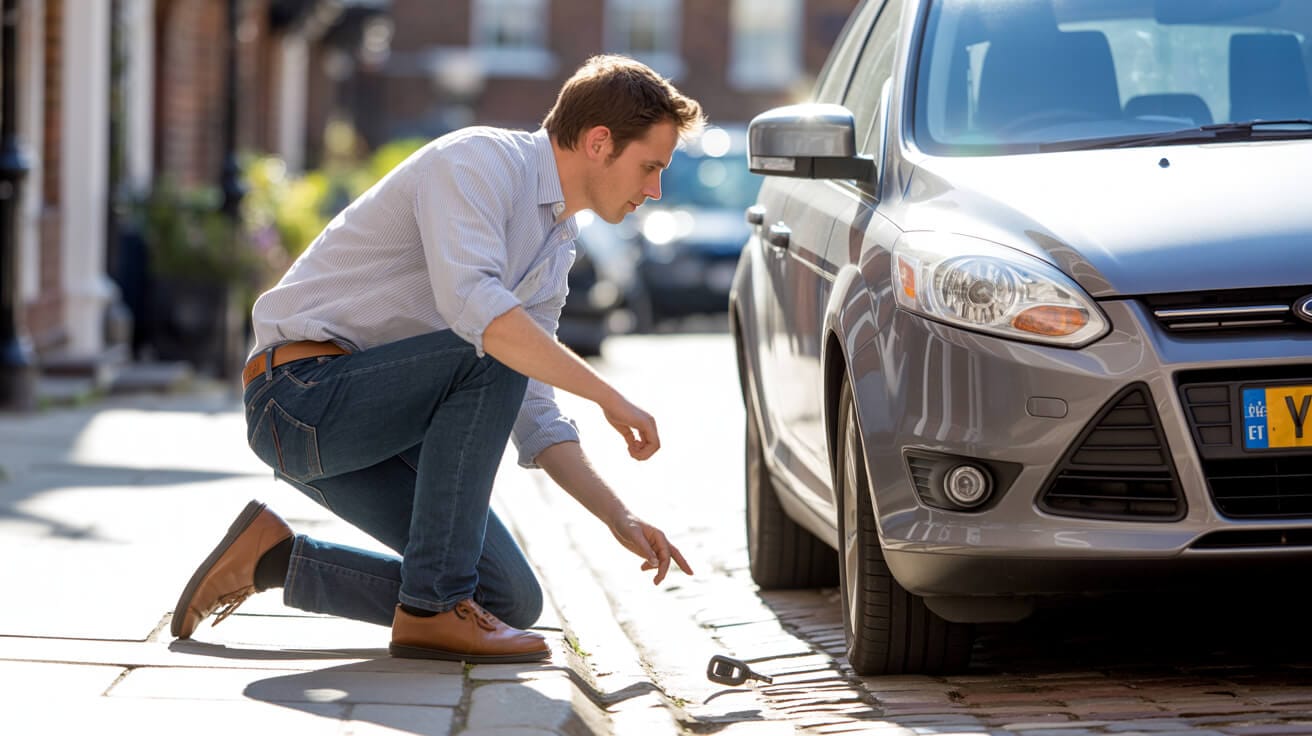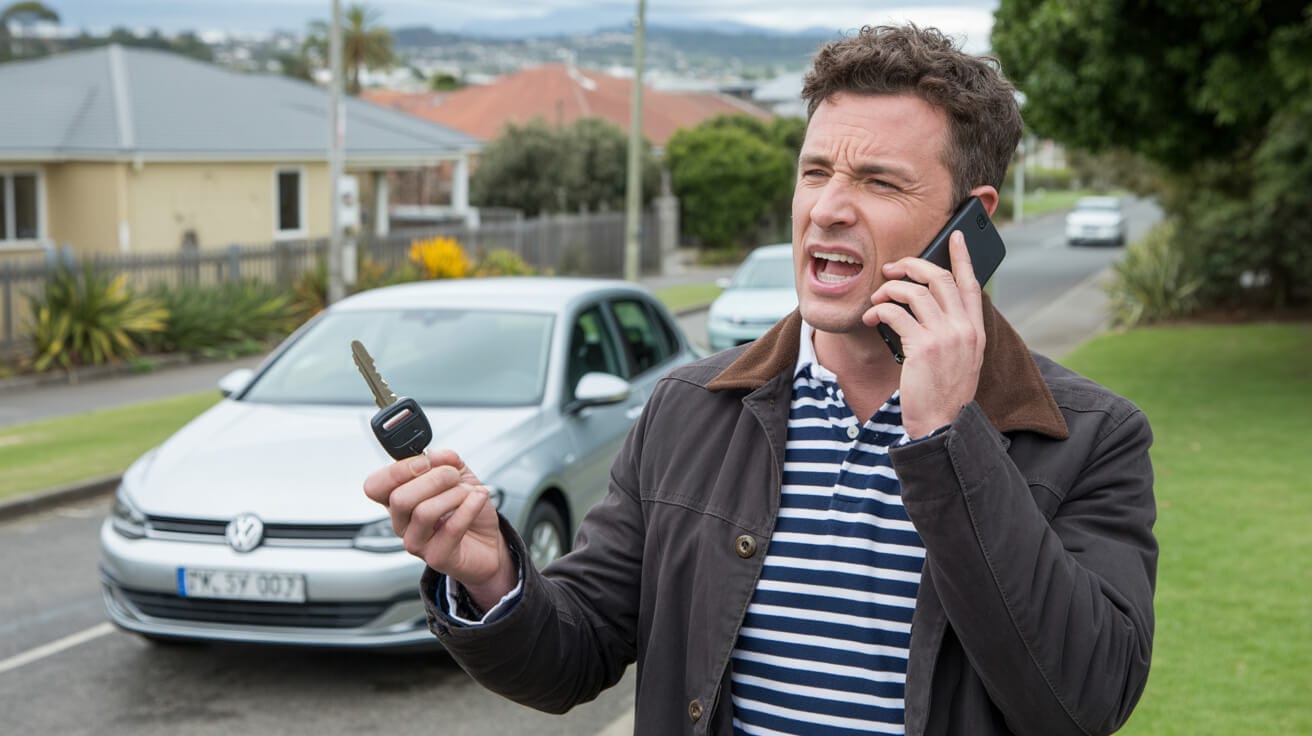Why Do Car Keys Stop Working Out of Nowhere—and What Does It Really Mean for You?
If your car key or fob fails without warning, it’s never “just bad luck.” Sudden breakdowns are almost always a collision of ignored signals, overlooked wear, and system stress—all converging at the worst time. Waiting for the “big fail” costs you time, cash, and sometimes even your car’s warranty or data security. The reality: these failures are preventable, and knowing what to watch for keeps your day—and your peace of mind—under your control.
A dead key rarely arrives alone; it drags delay and expense right to your door.
Modern vehicle keys rely on a hidden teamwork of batteries, secure electronics, precision engineering, and legal compliance. One weak link—a tired coin cell, a corroded button, or a fumbled battery swap—can lock you out instantly. Throw in UK weather, digital anti-theft, and tough access laws, and the stakes are even higher. By spotting the early signs and refusing to ignore “just a quirk,” you keep your keys (and your car) on your terms.
Why “Sudden Key Failure” Is Never Just One Thing
Most people blame a single cause, like a battery, but your key system is multi-layered:
• Hardware (blade, lock, latch, actuator)
• Credentials (key code, immobiliser chip, remote/fob circuit)
• Signals (RF/UHF, low-frequency, BLE, NFC/UWB)
• Control (onboard modules, gateway, security handshake)
• Environment (weather, interference, age, wear)
Every layer can fail. Ignoring one only guarantees the next is waiting.
Transition: If you know what to spot—and act early—you can dodge the biggest costs and hassles. It starts with the battery, but seldom ends there.
If It’s Just the Battery, Why Won’t a New One Save You Every Time?

A dying coin cell is far and away the number one killer of remote keys and fobs in UK cars. But there’s a twist: swapping the battery only helps if the rest of your fob, its contacts, and tiny circuits are still intact. Poor installation, corrosion, or worn micro-buttons mean your fix could backfire, leaving you out of luck. Even a “fresh” battery won’t power dead solder joints or compromised circuit boards.
The world’s strongest battery can’t bridge a broken connection hiding inside your fob.
How to Tell: Is It Battery or Something Deeper?
- Key works up close but fails at a distance? Weak battery—replace ASAP.
- Intermittent unlocking or a fainter button “click”? Internal contacts are starting to give.
- Dead fob after a battery swap? Check battery polarity, spring tension, and case closure.
Step-by-Step: Stack the Odds for a Safe Fix
- Replace your coin cell every autumn, before deep cold stresses the system.
- Use only branded, spec-matched batteries to avoid voltage fluctuation.
- Wipe battery tabs and contacts with a lint-free cloth—avoid touching with fingers.
- Log the change; a simple note in your phone or glovebox does the job.
The smart move: if your fob or key fails immediately after battery service—or still misbehaves—don’t assume user-error. It’s time for a full diagnostic that checks buttons, solder joints, and water ingress before bigger problems land.
Are Invisible Signals and Everyday Environments Setting You Up to Fail?

Radio signals—those quiet, invisible waves—stand between you and your car. Shopping centres, crowded streets, stormy weather, and wireless gadgets can swamp or scramble your fob’s weak signal. Sometimes you’re left thinking something inside your vehicle is faulty, when outside noise is really to blame.
Your fob’s signal battles unseen interference—even your daily commute can become a gauntlet.
Classic Signs of Environmental and Signal Trouble
- Fob works perfectly at home, then fails in a car park, street, or after a weather change? You’re fighting interference, not a broken key.
- Happens more during rain, cold snaps, or when near big metal structures? Moisture or RF congestion blocks the handshake.
Quick Moves to Win the Signal Game
- Step back from metallic structures, shops, and crowded radio zones.
- Elevate your fob—try pressing it high towards the windscreen.
- If you have a smart key, hold the fob directly against the start button or sensor pad.
If these tricks bring your key back to life, the culprit isn’t your hardware or battery. Consistent trouble, however, means the problem lives deeper—inside modules, wiring, or worn components.
Could the Real Enemy Be Hardware, Grit, or Hidden Mechanical Wear?

Electronic diagnoses dominate talk, but your keys and locks are still very physical. Years of pocket grit, water, accidental drops, and plain old wear eat away at the key blade, lock cylinder, and actuators. Sometimes the biggest trouble arrives quietly—a bent blade or sticky button can mask itself as “battery drama” until you’re locked out.
Every worn-out key started out sharp. Don’t let small scrapes turn into day-wreckers.
Warning Flags: Is Mechanical Wear at the Root?
- Your key blade looks bent or rough, or the grooves are visibly worn.
- Buttons are “spongy”, stick in place, or don’t spring back sharply.
- Lock barrels turn with effort, grind, or hang up in cold or wet weather.
Fast Hardware Checks You Can Actually Do
- Inspect the key blade under bright light; look for notching, flattening, or cracks.
- Gently flex; no key should feel soft or twist.
- Listen to the locks—sluggish clicks or rough turning mean grit, corrosion, or actuator fatigue.
If small problems linger or a new symptom appears, don’t wait. Every hour of hesitation can transform a repair into a replacement (and void that warranty).
When Software Fights Back: Security Drifts, Programming Loss, or Module “Sleepers”

Modern vehicles use all manner of anti-theft software, rolling codes, and handshake routines to talk to their keys and fobs. When the handshake fails—a lost code after a dead battery, modules napping after months unused, or a fob’s identity clearance lapsing—you’re locked out even if nothing “looks” wrong. Dashboard icons, especially a padlock or key symbol, are your car’s quiet “call for help.”
Electronic drift can lock out even the best hardware. A security handshake isn’t a handshake if nobody answers.
How to Know: Is Your Software Outsmarting You?
- Key unlocks the door just fine, but the engine refuses or scattershot dashboard icons appear.
- New battery, old fob, and still a no-go? The immobiliser handshake needs a reset.
- After a long holiday or deep cold, the electronics “forget” their pairings.
Solving Security and Programming Obstacles
- Only proceed with professional, authorised programming—anything else risks total lockout and warranty pain.
- Expect all steps (including driver ID check and consent) logged; no “cowboy fixes”.
- Embrace full transparency: every key event, every software session tracked and backed up.
If your car and key need reintroducing, let an expert handle the handshake—you’ll keep your data, warranty, and claim rights intact.
Can Unseen Wiring or Door Grommet Fatigue Really Be the Culprit?

Outside the fob, wiring looms—especially those snaking through doors and boots—are prime suspects in “phantom” key failures. Years of flexing, water ingress, or heat can crack wires or pull pins out of connectors. This kind of damage can mimic fob or battery loss, trapping owners in costly, recurring cycles of guesswork.
Door grommets: where old wires conspire to mimic dead fobs every winter.
Silent Clues the Fault Lies in the Wiring
- Functions fail on only one door, or symptoms change with weather or door movement.
- Features on one side of the vehicle show intermittent life—then die without pattern.
- You can “revive” functions briefly just by moving the door or cable.
Table: Rapid Fault Location Is Your Early Warning
A quick-reference table to demystify root causes:
| Cause | Typical Symptom | Best Action |
|---|---|---|
| Battery/Coin Cell | Dead everywhere | Branded battery swap |
| Door loom/grommet | Fails one door, varied | Harness repair |
| Water/corrosion | Buttons stick, LED flicker | Open, clean, shell fix |
| Module fault | Locks, no start | Secure reprogram |
A skilled locksmith won’t just replace batteries—they’ll hunt wiring problems with measurements and photo logs. It’s how you avoid “fixing” the wrong thing, over and over.
Why You Should Always Demand Non-Destructive, Audit-Ready Repairs

Any repair that cuts, drills, or over-writes modules without real cause risks both your car’s value and your legal standing. Non-destructive-first isn’t just best practice; it’s mandatory in the UK. Every professional step—from lockpicking to diagnostic reset and programming—should leave your car, and your audit trail, spotless.
A fix that leaves a scar isn’t a fix. It’s a future argument with your insurer.
How To Tell: Is This a Safe, Non-Destructive Repair?
- You’re asked for photo ID and proof of ownership before work starts.
- Every action—fob programming, lock service, or starter reset—is documented with photos and a digital trail.
- You’re given real demonstration of every function before the bill is paid.
Red Flags and Recovery Steps
- If a locksmith talks about “drilling first,” pause—there are better paths.
- Insist on an aftercare pack: photos, a digital job log, warranty record, and practical advice.
- Expect only legally approved hardware, subcomponents, and Pin traceable tools.
When your repair is photo-documented, compliant, and traceable from first touch to handover, you secure your car’s value and future peace of mind.
How “Authorised Access Only” Keeps Your Warranty, Data, and Claims Safe

In the UK, lawful access isn’t bureaucracy—it’s your shield against fraud, denial of insurance, and hidden risks. No genuine locksmith will skip ID checks, slack on job logs, or ignore consent—a process designed to protect you, your data, your car, and your legal standing. It’s stricter on new cars and digital keys, but that’s exactly what you want.
Rules aren’t a burden—they’re your real lock on value, data, and worry-free driving.
How the Best Providers Keep You Safe
- ID and V5C checks before a tool touches your vehicle.
- Job logs recorded to the minute—“who, when, with what tool.”
- All software, hardware, and spare parts tracked for warranty defence.
- GDPR, ISO data privacy, and functional safety rules built in.
When the paper trail matches the service trail, your next MOT, sale, or insurance claim won’t leave you exposed.
Why Autolocks Ltd Is the “Proof-First” Choice for Owners Who Can’t Afford Lockouts
Whether you’re locked out in the rain, chasing a mystery key fault, or prepping for a future sale, Autolocks Ltd isn’t just a fixer—we are your audit-ready, non-destructive, and insurance-safe shield. Each visit means instant action (60–90 minute emergency coverage in most cities), pure transparency (every step photo-documented), and zero shortcuts (compliance, warranty, and aftercare, always).
Every job ends with an aftercare pack: signed-off, digital logs, warranty coverage, and simple tips for lasting security—no up-sell, no pressure, just peace of mind.
If your car key fails out of nowhere, protect yourself with audit-grade, compliance-tight support. Choose Autolocks Ltd when you value non-destructive, photo-documented vehicle key repair with full traceability and warranty-safe results—so your day never stops with your key.
Frequently Asked Questions
Why Do So Many Car Key Failures Start Invisibly—And What’s It Really Costing You?
Most car key disasters are years in the making. The breakdown feels sudden—until you remember the times the buttons needed extra pressure, the fob only worked next to the window, or you shrugged off a flashing dashboard icon as a “quirk.” These aren’t random glitches. In reality, worn blades, stale batteries, and signal clutter combine with UK weather and digital complexity to trigger failure at the worst moment. Every time you delay a minor check-up, the odds of a lockout (and a bigger bill) climb. Missed issues could even void your warranty, expose your data, or turn your car into an easy theft target.
Locks fail loud, but decline begins in silence. The time to act is before you feel the pain.
Modern keys are loaded with sensitive electronics, micro antennas, encrypted chips, and security modules designed to stop theft. One battery swap won’t solve root-level risk. Ignoring creaky locks, corroded contacts, or fading fob range can spiral into expensive rescue calls or ongoing security problems. A five-minute Autolocks Ltd diagnostic—catching minor corrosion, misaligned latches, RF interference, and battery weakness—costs less than an emergency callout or a denied insurance claim.
Where Do Most Key Issues Brew—and How Do They Snowball?
- Cold UK winters drain coin cells fast, leading to “phantom dead keys.”
- Retail parks and contactless doors jam signals; your fob’s range can shrink overnight.
- Blade wear and tiny bits of grit silently grind away lock barrels.
- Missed software updates make fobs “invisible” to new immobiliser algorithms.
- Spilled drinks or even morning dew create moisture paths for hidden corrosion.
Spotting these signs early turns a potential crisis into an easy, affordable fix. With every inspection logged and step photographed, Autolocks Ltd makes sure your keys stay sharp, your records complete, and your car’s value safe.
Is It Really Just the Battery—Or Are You Missing a Critical Fault in Your Key or Fob?
Many owners pop open their fobs at the first sign of trouble, swap the battery, and hope for the best. Here’s the truth: more than half of “dead” fobs still refuse to start after a battery change. Why? Underneath, the soldered circuits and switches are fragile. One static zap, reversed cell, or rough snap-fit can break a vital connection. Moisture or dirty hands ground out the finest track. The mistake? Assuming every electrical silence is a dead coin cell instead of a wiring wound, a damaged contact, or a corroded pad.
Fresh batteries don’t resurrect a fob whose heart—the circuit—has crumbled out of sight.
How to Distinguish Surface Symptoms from Hidden Sabotage
- If you can only unlock the car up close, it’s likely battery fatigue; if not, consider deeper faults.
- Persistent trouble after a battery swap means corrosion, cracked boards, or broken micro-switches are likely at fault.
- Any failed DIY fix can make future repairs much harder or more expensive.
A professional check with Autolocks Ltd means safe handling, static protection, and component-level testing. We clean, test, log, and document every step, so your data and warranty remain intact—and your fob returns to reliable form, not just temporary luck.
What Invisible Forces—Like Signal Interference—Are Wrecking Modern Car Keys in the Wild?
You can’t see radio-frequency chaos, but your key feels it every day—especially around shops, tower blocks, and crowded city streets. Your fob’s encrypted handshake can be drowned out by security gates, wireless payment sensors, neighbouring cars, or even badly shielded household gadgets. When your car unlocks perfectly on your driveway but ignores you next to the shopping trolley bay, you’re not imagining it. Environmental conditions like rain, fog, or even a cold snap can also block or scramble signals, shutting out an otherwise healthy key.
When airways get clogged, even the best circuit is just pressing into silence.
Practical Moves to Guard Your Access and Money
- Step away from metal obstacles, power lines, or barriers—and watch range return.
- For push-to-start cars, press your fob flat to the sensor or dash pad to override interference on the spot.
- Troubleshoot in dry, open places first before judging your key “dead.”
If signal issues recur or alternate environments offer no joy, suspect a hardware problem in the antenna, wiring, or module. Autolocks Ltd offers environmental diagnostics—catching interference, testing network health, and saving you from needless hardware swaps.
How Do Physical Key and Lock Problems Sneak Up and Lock You Out—And How Can You Stop Them?
It’s easy to blame electronics, but most keys “fail” due to mechanical wear you never notice: the slow dulling of a key, a barrel that gets stiff in winter, or the pressure of a hundred pockets filled with coins or sand. A micro-crack or misaligned pin can leave you stranded after a simple turn—or lock you out on a rainy night.
Every key’s storey starts sharp—the slip comes from life, not laziness.
Head Off the Hassle with Early, Zero-Damage Checks
- Feel for nicks or burrs on your key blade; anything but smooth is a silent warning.
- Do buttons pop back with a click, or do they feel sticky? That’s clue to act before electrical failure.
- Locks that feel gritty, slow, or grind are likely to jam when you least expect—and cost more if ignored.
Get faults photographed and fixed early. Autolocks Ltd uses non-destructive practices, documents before-and-after, and returns your car to full health—no guessing, no damage, no waiting for a full lockout to force your hand.
Why Does Non-Destructive, Traceable Key Repair Matter for Your Warranty and Resale in the UK?
In the UK, any repair that starts with a drill, a guess, or a “trust me, mate” storey is a repair that damages more than your lock—it’s a risk to your warranty, insurance, and MOT compliance. Laws and best practices demand everything is owner-verified, stepwise, and logged: from who did what and when, to a photo record and clear outcome demonstration. Accept a shortcut and you inherit gaps—like missing digital records, unapproved access, or voided cover—that only show up when you try to sell, claim, or update your vehicle.
A car with a full trace looks better—to insurers, buyers, and you—than one missing its storey.
Spot the Signs of Real-Proof, Compliance-Led Service
- No tool touches your car before your rights and identity are checked and confirmed.
- Every step leaves a trace: digital photo, timestamp, technician and job ID, and a final access demo.
- Your receipts come with recorded aftercare, warranty confirmation, and plain-English next steps.
Autolocks Ltd insists on these standards—using ISO and GDPR-compliant processes, delivering you not just a quick fix, but a documented asset that preserves your vehicle’s value, legal standing, and peace of mind.
What Makes Autolocks Ltd the Gold Standard for UK Car Key Security, Owner Confidence, and Future Resilience?
Fast fixes are everywhere, but only a service that combines speed, proof, and care keeps you protected against tomorrow’s headaches. Autolocks Ltd leads with a “compliance-first, value-always” promise: UK-wide 60–90-minute emergency callouts, same-day repairs, owner-verified and non-destructive by policy, and every step evidenced—photos, logs, aftercare guides. Every technician is trained in both the latest digital systems and timeless craftsmanship; no shortcuts or script reading here.
We’ve rebuilt keys for families stranded in the rain, protected fleets facing urgent compliance audits, and helped owners defend their warranty with bulletproof logs. When your keys fail, or you want security built for the real world—not just theories—choose the partner who turns every job into an insurance for your history, your records, and your peace of mind.







